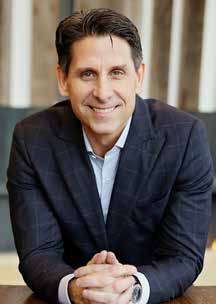One Size Does Not Fit All
Dan Kleckner has discovered that achieving long-term client success requires balancing individualized programming with each client's lifestyle demands.

Dan Kleckner is the co-owner of Kutting Edge Fitness in Kirkland, Washington. He has a bachelor's degree in applied health science from Montana Tech of the University of Montana and is a certified exercise physiologist through the American College of Sports Medicine. He is also a Level 2 Titleist Performance Institute Golf Fitness Professional. He has been a fitness coach for the past 10 years and has been mentored by some of the top fitness business professionals and golf fitness professionals in the country.
ACE: As the owner of a fitness studio, what challenges have you noticed are pre-eminent when it comes to addressing the unique needs of clients affected by obesity?
Dan Kleckner: I think the biggest challenge is helping them find a plan that fits their personal needs. Too many times, clients affected by obesity are thrown into a one-size-fits-all fat loss plan that can be successful in the short term, but that often leads to the vicious "yo-yo cycle" of losing weight and then gaining it all back. At Kutting Edge Fitness, we work with each individual to find the plan that best fits his or her needs and lifestyle. This can be challenging at times, but it leads to much better long-term results.
ACE: What strategies have you adopted to reach out to members of your community who are affected by obesity? What types of specialized programming do you offer that suits the needs of this population?
Dan Kleckner: We pride ourselves on being very active in our community so that we can help as many in this population as possible to lead healthier lifestyles. We participate in local health fairs, and we go to our current members' places of work to provide nutrition seminars, workout programs, etc. We also partner with other healthcare professionals in our area to host events that make it easy for community members with obesity to get access to a variety of resources that will improve their health. As far as specialized programming goes, we really believe in taking a comprehensive approach that involves nutrition consulting, exercise programming and development of healthy habits.
ACE: In terms of exercise equipment and facility amenities, what kinds of things do you believe can help people with obesity to begin and maintain a physical activity program?
Dan Kleckner: I don't believe you need a lot of equipment to be successful in helping clients with obesity to begin and maintain a physical activity program. These clients tend to have a pretty low level of self-efficacy when they start a program, and the equipment they see around the facility often intimidates them. It's a good idea to begin by building foundational skills through body-weight training and simple free-weight exercises. We've found that this approach helps clients to move better and get started on their quest to live healthier, more active lives.
ACE: In your opinion, what are some approaches that might help bring different sectors of the community (e.g., business, health care and local government) together to address the obesity epidemic?
Dan Kleckner: I believe collaboration is the key. I think it would be great to have a system in place that allows accredited healthcare professionals to refer patients/ clients to each other within the accredited group. That way, doctors could prescribe exercise to clients affected by obesity and refer them to trainers whom they (the doctors) trust. I also think it would be helpful to have the different sectors meet regularly and host community events together—and even set up a committee composed of top individuals in each field. We each have our own area of expertise and, by working together, we could provide a holistic and unified approach to fight the obesity epidemic.
ACE: What strategies have been most effective for improving body composition and/or general health when working—either one-on-one or in group settings—with clients who are affected by obesity?
Dan Kleckner: We have had success with clients in both one-on-one and group settings, but we have found over time that the semiprivate setting works best, which is where we have three clients training with one coach. This allows us to create individual programs for each client, but it also creates a sense of community, camaraderie and personal accountability. The social support tends to bring out the best in people.
Of course, it's important to remember that some clients prefer the privacy and personal attention that come with a one-on-one training session. It is essential that trainers really listen to each client in order to figure out what will work best for him or her—and what will keep each client motivated to keep visiting the facility and living an active lifestyle.
Our hourlong workouts, whether they are one-on-one or conducted in small groups, typically include a dynamic warm-up, mobility work, core exercises, power/athletic movements, full-body strength training, metabolic conditioning, and a cool-down that features breath work. We usually ask our clients to supplement this workout, which they perform three times per week, with cardio or group fitness exercise.
Editor’s note: Bridging the Gap is a series of interviews conducted by ACE with professionals throughout the fitness and allied health industries, as well as our partners in the corporate world. ACE hopes this column will start a conversation among those entities about the impact of the obesity epidemic and how we can all work together to eliminate it by 2035.




